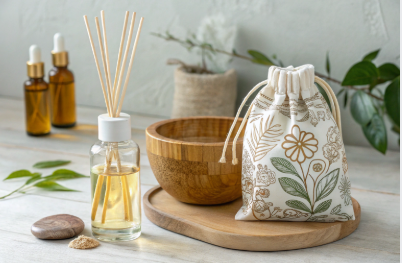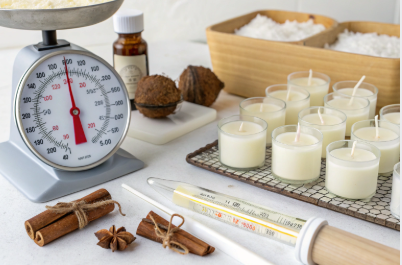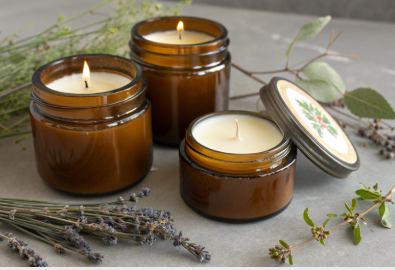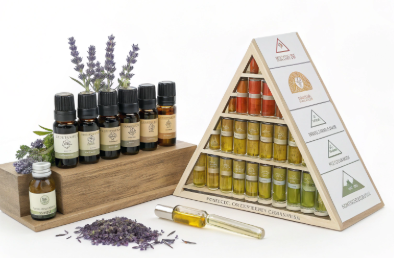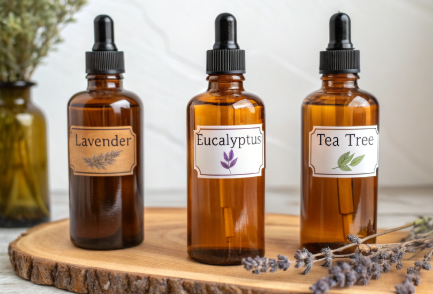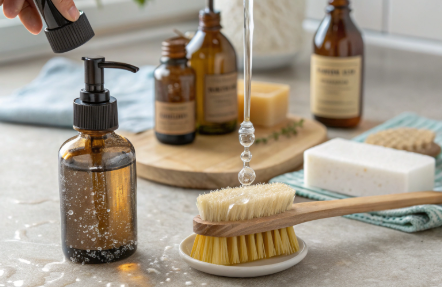Ever lit your essential oil candle only to find the scent disappears within minutes? It’s frustrating—especially when you’ve invested in natural ingredients.
To make essential oil fragrances last longer in candles, use the right wax, heat the wax to the optimal temperature before adding oils, and follow proper ratios for scent retention.
Natural doesn't have to mean weak. With the right blend of technique and formulation, your essential oil candles can be both aromatic and long-lasting. Let’s dive in.
How do you make essential oil candles smell stronger?
We’ve all been there—your DIY essential oil candle looks great, but it barely smells when burning.
For stronger-smelling candles, combine essential oils with soy or coconut wax, add oils at the right temperature (around 185°F/85°C), and use enough fragrance—typically 6–10% of wax weight.
Here's how to optimize scent throw in essential oil candles:
1. Choose the Right Wax
Natural waxes like soy or coconut blend better with essential oils than paraffin, which is more compatible with synthetic fragrance oils.
2. Master the Pour Temperature
Add essential oils when wax is hot enough to bind but not too hot to burn the scent off. 185°F (85°C) is ideal.
3. Use Enough Essential Oil
Most DIY crafters underdose their candles. For strong scent, use at least 6–10% essential oil by wax weight. For a 100g candle, that’s 6–10g of oil.
| Wax Type | Scent Throw | Eco-Friendly | Ideal for EO |
|---|---|---|---|
| Soy Wax | Moderate | Yes | Yes |
| Coconut Wax | Strong | Yes | Excellent |
| Beeswax | Light | Yes | Limited |
| Paraffin Wax | Very Strong | No | Not ideal |
How to make essential oil scent last longer?
Strong scent is one thing—lasting power is another. Essential oils can evaporate or degrade if not handled correctly.
To make scents last longer, store candles properly, cure them for 7–14 days, and use stabilizing blends or fixatives like essential oil anchors (e.g. vetiver, patchouli).
Dive Deeper: How to lock in that scent
1. Use Base-Note Essential Oils
Base-note oils like sandalwood, cedarwood, and vetiver naturally last longer. Blending these with top notes helps anchor lighter scents like lemon or peppermint.
2. Cure Before Lighting
Candles need time to “set.” Let them cure in a cool, dark place for at least a week before use to enhance scent throw and stability.
3. Proper Wick Selection
The wrong wick can overheat the wax and burn off fragrance too quickly. Choose a wick that matches your wax type and jar size.
Bonus Tip from PauPack:
If you're producing in bulk, consider using our eco-glass jars with airtight lids. Our packaging helps retain scent quality during storage and shipping—an often-overlooked factor in commercial candle quality.
Why don't my essential oil candles smell?
The candle looks great, the wax is smooth—but where’s the scent? This is one of the most common issues for beginner chandlers.
Essential oil candles may lack scent because of incorrect oil temperature, insufficient dosage, incompatible wax, or poor curing.
Let’s troubleshoot the most likely culprits:
1. Wrong Temperature at Oil Addition
Add oils too early (above 200°F), and they’ll evaporate. Too late (below 160°F), and they won’t bind to the wax.
2. Low Essential Oil Concentration
Using only 2–3% of oil will result in a weak scent. Aim for 6–10%.
3. Wax Incompatibility
Some waxes, like beeswax or low-grade soy blends, don’t hold EO well without additives.
4. Improper Candle Size to Room Size Ratio
A small candle won’t scent a large room. Use multiple wicks or larger jars to expand the throw.
5. No Lid or Loose Packaging
A candle left uncapped loses scent over time. That’s why at PauPack, we always recommend air-tight, recyclable lids for all candle jars.
What is the 30/50/20 rule for essential oils?
Blending essential oils is an art—and science. If your candle smells “off” or inconsistent, your oil ratios might be the issue.
The 30/50/20 rule is a blending guideline: 30% top notes, 50% middle notes, and 20% base notes to create a balanced, lasting scent.
Understanding the Rule:
-
Top Notes (30%): First scent you notice; usually light and uplifting (e.g., lemon, peppermint).
-
Middle Notes (50%): The heart of your blend, often floral or herbal (e.g., lavender, geranium).
-
Base Notes (20%): Heaviest and longest-lasting, helps "fix" the blend (e.g., patchouli, sandalwood).
Sample Blend:
Let’s say you’re making a lavender lemon candle:
-
Lemon (Top) – 30%
-
Lavender (Middle) – 50%
-
Cedarwood (Base) – 20%
Why This Matters for Candles:
Candles burn slowly, and the scent evolves as it melts. A well-structured blend ensures your fragrance smells good from start to finish.
What kind of wax holds essential oils best in candles?
It all starts with wax. If your candle’s foundation can’t bond with essential oils, even the best scents won’t last.
Soy wax, coconut wax, and blends with botanical additives offer the best fragrance retention for essential oils due to their natural binding properties.
Understanding Wax Options:
1. Soy Wax
This plant-based wax has a smooth texture and moderate scent throw. It works well with mid-weight essential oils like lavender or eucalyptus. Affordable and beginner-friendly.
2. Coconut Wax
Superior scent throw, creamy texture, and excellent EO retention. It’s pricier but ideal for premium candles. Its low melt point helps diffuse essential oils gently over time.
3. Soy-Coconut Blend
A hybrid of performance and cost-efficiency. It balances scent release and burn time, making it a great option for scalable production.
4. Beeswax
Natural but thick, it tends to overpower or suppress lighter essential oils unless blended with carrier oils or soft waxes.
| Wax Type | EO Retention | Burn Time | Eco-Friendly | Best For |
|---|---|---|---|---|
| Soy | Good | Long | Yes | Entry to Mid |
| Coconut | Excellent | Moderate | Yes | Premium |
| Soy-Coconut Mix | Very Good | Long | Yes | Mid to Premium |
| Beeswax | Fair | Very Long | Yes | Rustic/Niche |
At PauPack, we work with candle brands to provide packaging compatible with all wax types. Our glass jars withstand heat and help preserve scent—perfect for your chosen wax base.
When is the best time to add essential oils to melted wax?
Add oils too soon, and they’ll burn off. Add them too late, and they won’t mix properly. Timing matters.
The best time to add essential oils is when the wax reaches 185°F (85°C), which allows optimal dispersion without degrading the scent.
Why This Temperature Works:
-
Above 200°F: Many essential oils start to break down, especially citrus and floral types.
-
Below 160°F: Oils might not blend uniformly into the wax, leading to uneven scent throw.
Pro Tip:
Use a digital thermometer to track your wax temperature precisely. At PauPack, we offer candle containers with wide mouths for easy pouring and mixing—designed for both artisans and commercial manufacturers.
How do candle jar designs affect essential oil scent retention?
The vessel isn’t just decoration—it can make or break scent performance.
Thick-walled, lidded jars with narrow openings help retain essential oil fragrance by minimizing evaporation and regulating burn temperature.
Let’s break down the science of scent preservation:
1. Jar Thickness
Glass jars with thicker walls insulate better and prevent rapid temperature fluctuations, which helps with even scent release.
2. Jar Opening
Smaller openings concentrate the aroma. Wider jars may diffuse scent more broadly but can weaken it quickly in large spaces.
3. Lids Matter
Always use air-tight lids post-pour and during curing. This traps volatile oils that might otherwise escape.
At PauPack, our candle packaging includes eco-friendly, airtight bamboo and aluminum lids that not only look beautiful but help preserve the candle’s scent integrity during storage and transit.
Can you blend essential oils for longer-lasting candle aromas?
Not all essential oils are created equal. Some fade fast. Others linger for hours.
Yes, by combining base, middle, and top note essential oils, you can create balanced, long-lasting candle scents using structured blending methods.
Use the “Fragrance Pyramid”:
-
Top Notes (fast-fading): Citrus, mint, tea tree
-
Middle Notes (heart of the blend): Lavender, rosemary, geranium
-
Base Notes (last the longest): Cedarwood, patchouli, vetiver
Ideal EO Ratio:
Follow the 30/50/20 rule:
-
30% top notes
-
50% middle notes
-
20% base notes
This creates an evolving scent experience—from the first light to the final hour.
At PauPack, we encourage our B2B clients to develop custom fragrance blends. We provide samples and visual mockups to ensure scent and packaging align perfectly with your brand.
How do curing and storage impact essential oil candle scent?
Even if everything else is perfect, skipping curing can sabotage your scent.
Curing essential oil candles for at least 7–14 days in a sealed, cool, dark environment helps solidify scent bonds and maximize fragrance throw.
Curing Do’s:
-
Store candles with lids on.
-
Keep them away from direct sunlight or heat.
-
Don’t light them before curing—scent release won’t be consistent.
Long-Term Storage:
Use packaging that’s air-tight and scent-preserving. For bulk orders, we recommend shrink-wrapped candles in UV-blocking glass containers. These are available in PauPack’s home fragrance packaging line.
| Storage Factor | Impact on Scent | Recommendation |
|---|---|---|
| Sunlight Exposure | Degrades oils | Use UV glass jars |
| Air Exposure | Evaporates scent | Always use a lid |
| Temperature Swings | Alters wax/oil bond | Store in a cool, dark room |
Conclusion
Making essential oil candles smell great and last long isn’t luck—it’s method. From wax and temperature to packaging and curing, every detail matters. At PauPack, we help fragrance brands get it right—from formula to flame.




